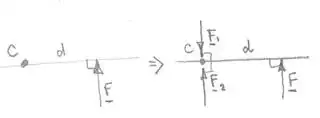One can make reasonable assumptions to investigate the problem in a simple manner. Here is my reasoning about this question.
For the sake of simplicity let us assume we have a spherical object of radius R in the outer space. Let there be a hook at the surface of the sphere from which we can attach a string. Imagine we are equipped with a rocket system that can give us momentum to move about.
Now, we hold one end of the string and move away from the sphere in a direction that the string, when it becomes taut, is not parallel to the radius of the sphere. The force we exert on the sphere in that direction can be analysed into the tangent and the perpendicular to the surface of the sphere. If $\theta$ is the angle between the string and the normal to the sphere we have:
Tangent component: $F_T=F\sin(\theta)$
Normal component: $F_N=F\cos(\theta)$.
The normal component is parallel to the radius of the sphere and passes through the centre (CM) and has no moment. This component will pull the sphere in the normal direction.
The tangent component has a moment with respect to the centre
$M=FR\sin(\theta)$.
This component would rotate the sphere, should the axis of the sphere be pivoted, but it is not! However, I believe that, due to the inertia of the mass of the sphere, it would be sufficient to give pivotal leverage for the tangent force to rotate the sphere. The law of conservation of energy must be written, for a short time interval of application of the force, in the form
${\bf {F.x}} = {\frac {1}{2}}mv^2+ {\frac {1}{2}}I{\omega}^2 $
where:$\bf x$ is the displacement of the sphere, while the first term on the RHS is the kinetic energy due to the linear motion, and the second is the kinetic energy due to the rotational motion. Note that, as the sphere has no fixed axis, it will rotate about the axis which is peprepndicular to the great circle passing through the point of the hook, and the $F_T$ is tangent to it. Hence the axis will be perpendicular to $F_T$ and $F_N$ and so it is perpendicular to the force $\bf F$. This will be the case for any direction of $\bf F$.
Why should the axis of rotation pass through the CM? The poitn here is that the object is rotating freely. Is not constrained to rotate about an arbitrary axis. Without going into mathematics, a quick argument from physics point of view is that, if the axis passed through another point, the rotational motion would be unstable. I mean that for a freely rotating object, there is a minimum state of energy, and this is when the axis of rotation passes through the CM. If it passed through some other point, then according to the parallel axis theorem, the inertia of the object would be higher, hence higher energy of the system. It is like you bring an object at a certain height near the surface of the earth and then you set it free. It will fall to the lowest energy state, and that is when it is on the ground.
